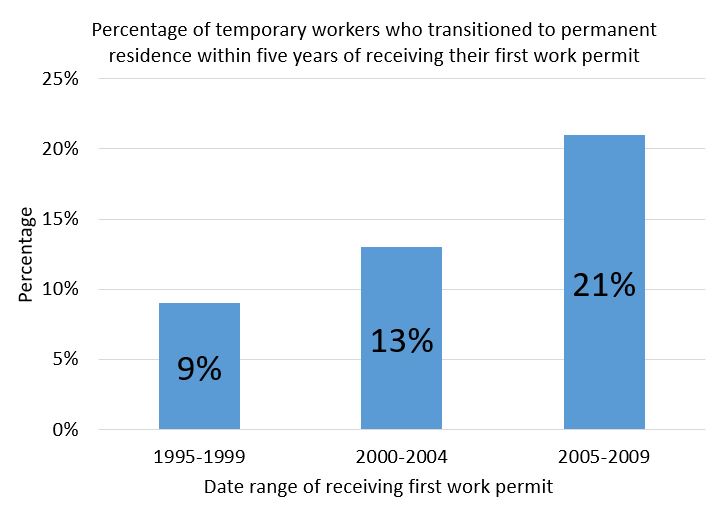Rate of Temporary Foreign Workers Immigrating to Canada Permanently Increased Between 1990 and 2014
New data released by Statistics Canada reveals that an increased share of foreign workers in Canada successfully transitioned to permanent resident status over the period 1990 to 2014 — a trend that may well have continued since 2014 and beyond. This is in no small part due to immigration programs that value Canadian work experience.
About nine percent of temporary foreign workers who received their first Canadian work permit between 1995 and 1999 became permanent residents within five years. The level increased to 13 percent for the 2000-to-2004 arrivals, and it rose further to 21 percent for foreign workers who arrived between 2005 and 2009.
Foreign workers may come under one of two broad programs: the Temporary Foreign Worker Program (TFWP) or the International Mobility Program (IMP).

Over the period of time under scrutiny in this study, Canadian federal and provincial governments have launched a number of programs that allow foreign workers to obtain permanent residence. The Provincial Nominee Programs (PNPs) allow Canadian provinces and territories to nominate eligible individuals who wish to immigrate to Canada and who have the credentials to establish themselves in a particular province or territory. In addition, the Canadian Experience Class (CEC) — an immigration program first introduced in 2008 — allows foreign workers to become eligible for permanent resident status once they meet certain eligibility criteria.
The CEC is one of three federal economic immigration programs managed under Canada’s Express Entry immigration system (the other two being the Federal Skilled Worker Class and the Federal Skilled Trades Class). Because Express Entry was launched in 2015, and the study does not include any data from this system.
However, the report does mention Express Entry explicitly, stating that the emphasis on pre-arranged job offers, Canadian work experience, and English or French ability in the Express Entry system also benefits temporary foreign workers seeking permanent residence.
A pre-arranged job offer can be, but is not always, a determining factor for becoming eligible to enter the Express Entry pool of candidate. In addition, a qualifying job offer is one of the factors for which a candidate in the pool may be awarded points under the Comprehensive Ranking System (CRS). The CRS is a unique points system used by Immigration, Refugees and Citizenship Canada (IRCC) to rank candidates and issue Invitations to Apply (ITAs) for permanent residence to the highest-ranked candidates during draws from the pool.
Be that as it may, the number of CRS points awarded for a pre-arranged job offer was reduced in November, 2016, when the number of points awarded for such an offer was changed from 600 to either 200 or 50, depending on the position offered, with IRCC wishing to place greater emphasis on human capital factors, skills, and experience.
“Obtaining gainful employment in Canada is a key step to settlement in the country, as well as for the immigration process itself,” says Attorney David Cohen. “The current government has gone on record stating that it wishes to place greater emphasis on human capital, skills, and experience, but a job offer remains valuable in its own right.”
It should be noted that Canada continues to allow a broad range of workers around the world, both within Canada and abroad, to immigrate through its economic programs. In fact, the overall number of immigrants coming to Canada has increased substantially since the 1990s, with this year’s target level of 300,000 new permanent residents being higher than any annual intake of any year included in the study.
To find out if you are eligible to immigrate to Canada permanently, fill out a free online assessment form.
To read the full report, click here.
© 2017 CICNews All Rights Reserved
- Do you need Canadian immigration assistance? Contact the Contact Cohen Immigration Law firm by completing our form
- Send us your feedback or your non-legal assistance questions by emailing us at media@canadavisa.com




